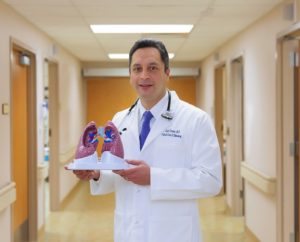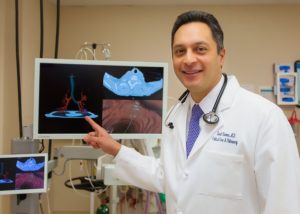Catching It Early | by

Sky Ridge Screening and Diagnostic Programs Help to Save Lives of Lung Cancer Patients
It’s a frequently repeated statistic, but never takes on the significance it is due until it directly affects you or someone you love: More U.S. residents — men and women — die from lung cancer than any other type of cancer. Unless caught early, a lung cancer diagnosis can be overwhelmingly negative. But there is better news on the horizon. The team at Sky Ridge Medical Center, with state-of-the-art, advanced technology, can now offer patients the chance to identify lung cancer in its earliest, more treatable stage.
Lung nodules are abnormal spots on the lungs that can been identified on a CT scan of the chest. Most nodules tend to be benign, but some nodules can be precursors to cancer. One common way of finding lung nodules is through a Low-Dose CT (LDCT) for those who are at high risk for lung cancer. To qualify for a LDCT Lung Cancer screening, an individual must be an active smoker or quit within the past 15 years, have a 30+ pack year smoking history, and be within the ages of 55 to 80. When a suspicious nodule is found, doctors will sometimes biopsy, or take a sample, of the nodule to identify whether or not it is cancer. In April, Sky Ridge Medical Center became the first in the Denver metro area to use Veran Medical Technologies’ SPiN Thoracic Navigation System, known more simply as navigational bronchoscopy (see “Bronchoscopy Basics”). This technology allows physicians to biopsy smaller and harder to reach nodules, helping to identify early-stage lung cancers. In addition to this, the lung cancer experts at Sky Ridge also use EBUS (endobronchial ultrasound), a modality that uses ultrasound in the patient’s airway to sample questionable lymph nodes for signs of cancer.
While this advanced-technology puts the Sky Ridge pulmonary care team at the leading edge of lung cancer treatment, there is a much more measurable benefit: Identifying lung cancer early greatly decreases the heavy burden of worry and anxiety that patients and their families often feel, says Pulmonary Critical Care Physician and Sky Ridge Medical Staff President Dr. Surit Sharma.
Identifying Lung Cancer Early Saves Life
Although the technology Dr. Sharma and his colleagues use has been around for about a decade, it wasn’t until last year that it was enhanced to the point in which he felt he and his Sky Ridge colleagues could achieve a noticeable difference in their ability to save patients’ lives.
“One of the reasons it’s important to identify abnormalities early in lung cancer is that the mortality benefit changes dramatically,” says Dr. Sharma.
The bronchoscopy procedures that he and his colleagues use can safely and precisely identify lung cancer in the earliest stage — 1A, which means there is a 70 percent chance or better of patients living five years past their diagnosis, and in some cases remaining in remission. Even with advances in medical oncology, survival drops significantly beyond this early stage.
Improving Technology Meets Demand for Health
Since acquiring the new technology, Dr. Sharma has used the navigational bronchoscopy technology to provide his patients with greater insight on their diagnosis and prognosis.
“For 80 percent of these individuals, this combination technology — EBUS and navigational bronchoscopy — has impacted the plan for patient care,” Dr. Sharma says. “Without it, the ability to accurately diagnose small lung nodules ranged between 20 to 40 percent.”
The technology, he cautions, might not be for everyone. “We screen our patients carefully and encourage those who are current or former smokers to consider a lung cancer screening first, which is similar to any other screening exam such as a mammogram or colonoscopy,” Dr. Sharma says. “Should we find a suspicious nodule, then we move to the diagnostic stage we just discussed. My hope is that with this technological advancement, we will be able to better care for our patients, diagnose lung cancer at an early stage and give us the best chance for cure for our patients.”
 BRONCHOSCOPY BASICS
BRONCHOSCOPY BASICS
What are EBUS and navigational bronchoscopy? Read on for how the technology works and what to expect as a patient.
Endobronchial Ultrasound Bronchoscopy (EBUS)
This minimally invasive diagnostic procedure uses sound waves to visualize enlarged lymph nodes or other lesions near the lungs’ main airways. These lesions can then be biopsied with a high degree of safety and success.
Navigational Bronchoscopy
A relatively newer procedure used to reach small lesions in the lungs, this technique is also minimally invasive and involves creation of a three-dimensional virtual “roadmap” of the patient’s lungs. This map enables the doctor to steer a bronchoscope with a specialized set of catheters through the lungs to reach small, peripheral lesions that were previously difficult to biopsy, enabling early diagnosis. This technique can also be used to place markers next to cancerous lesions to more precisely deliver radiation therapy while reducing exposure to surrounding healthy tissue.
What to Expect
Both EBUS and navigational bronchoscopy are minimally invasive, but are often performed with the support of an anesthesiologist to provide sedation and support breathing during the procedure. Most patients go home the same day of their procedure.
WHAT ARE THE BENEFITS OF EARLY DIAGNOSIS?
- Earlier treatment, which is proven to increase survival rates as high as 92 percent
- Less anxiety
IS LUNG CANCER SCREENING RIGHT FOR ME?
If you meet the following criteria, you are considered to be “high risk” for developing lung cancer and
screening is recommended:
- aged 55 to 80
- are a current smoker or have quit smoking within the past 15 years
- “30 pack year” (1 pack per day for 30 years, or 2 packs per day for 15 years, etc)
Call the Sky Ridge Medical Center Cancer Care Line at 720-225-2273 to learn more about lung cancer screening today.
Tags: Sky Ridge Medical Center
Leave a Comment
Please be respectful while leaving comments. All comments are subject to removal by the moderator.

